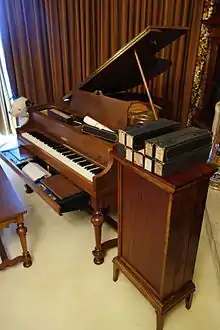American Piano Company
American Piano Company (Ampico) was an American piano manufacturer located in East Rochester, New York, The company In 1908 bought the William Knabe Co. Of Baltimore to add to their roster of fine piano companies. They had already bought Chickering Piano of Boston as well as Haines Brothers, Marshall & Wendell, and Foster, Armstrong & Company, all of East Rochester, New York. They later purchased the Mason and Hamlin piano company as their flagship piano.

From 1914 American Piano was one of the leading producers of player pianos as well as their reproducing player known as the Ampico. A reproducing player Piano was able to play back the actual playing of an artist with all the expression of the original performance. The dynamics and fine nuances were played only on reproducing players. These player rolls and the pianos that played them were rediscovered by a large group of collectors in the 1960’s forming a club known as the Automated Musical Instrument Collectors Association. Their main competitors in reproducing players were the Aeolian Duo-Art]] (1913) and Welte-Mignon (1905). The player piano and reproducing Ampico mechanism was originally designed by Charles Fuller Stoddard (1876–1958) with Dr. Clarence Hickman joining the company in the mid 1920’s. [1][2] A great number of distinguished classical and popular pianists, such as Sergei Rachmaninoff (1873–1943), Leo Ornstein (1892–2002), Ferde Grofé (1892-1972), Winifred MacBride, and Marguerite Volavy (1886–1951),[3] Adam Carroll, Frank Milne, And most prominent pianist of the era recorded for Ampico, and their rolls are a legacy of 19th and early 20th century aesthetic and musical practice. By the end of 1929 Ampico was in essential economic difficulties and was finally taken over by the Aeolian Company , a manufacturer of player pianos and organs. The combined company, known as Aeolian-American Corp., went through several ownership changes before declaring bankruptcy in 1985.
The Ampico was the name of their player piano system that they discontinued in 1941. The last model introduced was the Ampico Spinet Reproducing Piano, which had all the functionality of a reproducing piano, and although having a low cost of $495, had modest sales.
Rythmodik Music Corporation
produced piano rolls. The first rolls specially coded for the Ampico were made by Rythmodik.
History
Originally named Despatch after the transportation company that spawned several dozen car shops in the area, the town was also home to a musical manufacturing giant for the better part of the 20th century. Nestled in between the New York Central Railroad tracks and Commercial Street, the 250,000 square-foot edifice designed by Henry Ives was the first industrial building in the United States to be constructed from reinforced concrete.
Renowned for its fine craftsmanship, the American Piano Company was the largest distributor and manufacturer of pianos in the world by the mid-1920s. The instrument’s popularity reached its peak that decade thanks to a growth in prosperity and an increased interest in music stimulated by phonographs and radio. Piano producers across the country would not fare as well the following decade. Over 347,000 pianos were purchased in the United States in 1923, .[4]References
General references
- Larry Givens: Re-enacting the Artist: A Story of the Ampico Reproducing Piano, Vestal, N.Y.: Vestal Press, 1970.
- Elaine Obenchain: The Complete Catalog of Ampico Reproducing Piano Rolls, New York: American Piano Co., 1977
- History of Ampico, by The Pianola Institute, London, Accessed April 1, 2009
Inline citations
- Biography Index, A Cumulative Index to Biographical Material in Books and Magazines, Volume 4: September 1955–August 1958, New York: H. W. Wilson Company, 1960
- Obituaries on File, two volumes, compiled by Felice D. Levy (1917–1990), New York: Facts on File, 1979
- Who Was Who in America, Volume 7, 1977–1981, Chicago: Marquis Who's Who, 1981
- "The American Piano Company". democratandchronicle.com.
